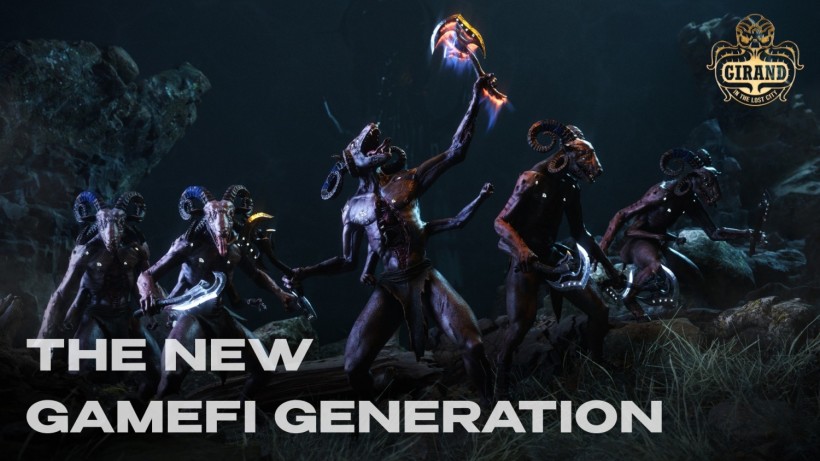
In recent years, the game industry has revolutionized, introducing blockchain technologies and opening up new financial opportunities in the game world. In this context, the MENA region (Middle East and North Africa) is gaining more and more attention, becoming a crucial player in the GameFi industry development and growth.
MENA is one of the key regions in the development and propelling of the GameFi industry. With its diverse culture, rich heritage, and dynamic game market, MENA is an ideal location for innovative gaming solutions. Companies in this region are actively creating and implementing blockchain-based games, creating a unique gaming experience and providing real financial opportunities.
One of the main events of early 2024 in the MENA market and the industry as a whole is the upcoming release of "GIRAND: IN THE LOST CITY," the alpha version of the new generation game.
GIRAND — The New GameFi Generation
The fascinating world of this AAA Play2Earn game features stunning and detailed 3D graphics depicting the game's metaverse—the ancient kingdom. From the first glance at the game, you can notice the developers' focus on each detail. Even the music you hear in the game trailer was composed in a professional studio specifically for the game, perfectly matching its ambiance and history. Inspired by Lovecraft and ancient Greek philosophers, this fantasy world tells the story of Atlantis.
Girand unites Web2 and Web3, making it easy for not crypto-savvy people to enter the game and engage with the digital economy without the need for specialized knowledge. New players don't have to create crypto wallets to start playing—it will be enough to log in via Telegram and the system will do the rest.
One of the main advantages of the game is its strong and dedicated team, each member of which really enjoys working on the project, making every effort to implement their best practices into it. Those people have a background working with such giants as Blizzard, Mail.ru, and 1C. Headquartered in Dubai, the project's team is scattered all around the world. Such an approach allows for picking the best professionals and uniting them for the sake of the creation of this groundbreaking game.
Sergey Fominyh—the inspirer and creator of GIRAND: IN THE LOST CITY—has been an owner of a digital agency for over 10 years. He is a professional investor and ex-co-owner of an investment club with in-house IT software.
Girand's Economy
Incorporating innovative game mechanics creates distinctive, non-linear, and thrilling gameplay experiences for every player. Girand's NFT-based gaming economy introduces a tax system for specific profitable transactions, imposing limits on payouts related to PvE activity and ratings. The step-by-step implementation of this system, paired with the P&E model, fosters steady growth in gaming activity.
One of the main problems for game projects is a Ponzi scheme. This fraudulent investment scam promises high returns with little risk to investors, using funds from new investors to pay the returns to earlier investors. This pyramid scheme is one of the main deterring factors for investors. Girand developers managed to solve this issue by implementing a variety of measures. The main idea was to create a game where gameplay, story, graphics, and metaverse would engage and motivate players much better than the idea of money-making.
The developers emphasize that Girand is primarily designed as a game. Their primary objective was to create an engaging experience for players, where the possibility to earn money comes as a bonus. This strategy aims to maintain player engagement across market cycles, enhancing Girand's resilience in response to changing market trends.
Still, how do players make money within the game? The main source of income comes from mining rare NFTs that players discover in the metaverse while playing. Mining new NFTs has no impact on existing ones, as there is no inflation in the game economy. Mining new NFTs is possible when creating new races, with each race having a limited number of NFTs. The release of a new race does not influence the value of existing ones.
Investors can efficiently use their tokens by dividing them into two equal parts, where 50% are locked in staking and the remaining 50% stay in the game. The staking period lasts 18 months. Staking participants automatically receive a share of the game's total revenue, proportional to the amount of locked funds, and also may participate in the draw of unique NFT collections. Important to note that the vesting of frozen tokens is a priority.
The first staking stage will become available for participation 2 months after the start of TGE. All tokens spent in gameplay will be burned, therefore, the total supply of tokens will continually decrease, creating scarcity and helping maintain token value. Such an approach creates beneficial prospects for investors, stimulating them to participate in the project's development more actively.
GIRAND: IN THE LOST CITY is going to become the top game in the MENA region, drawing players with its gripping storyline and innovative gameplay. It's not for nothing that the creators chose to place their head office in Dubai, claiming their project's global nature, including but not limited to aspirations to work in this region.
The game developers plan a large-scale offline tournament in the UAE at the end of this year. Everyone is welcome to participate and become a part of the community, meet like-minded people and game fans, and try their skills in the gameplay. That's going to be a great event and a real competition!
* This is a contributed article and this content does not necessarily represent the views of techtimes.com





